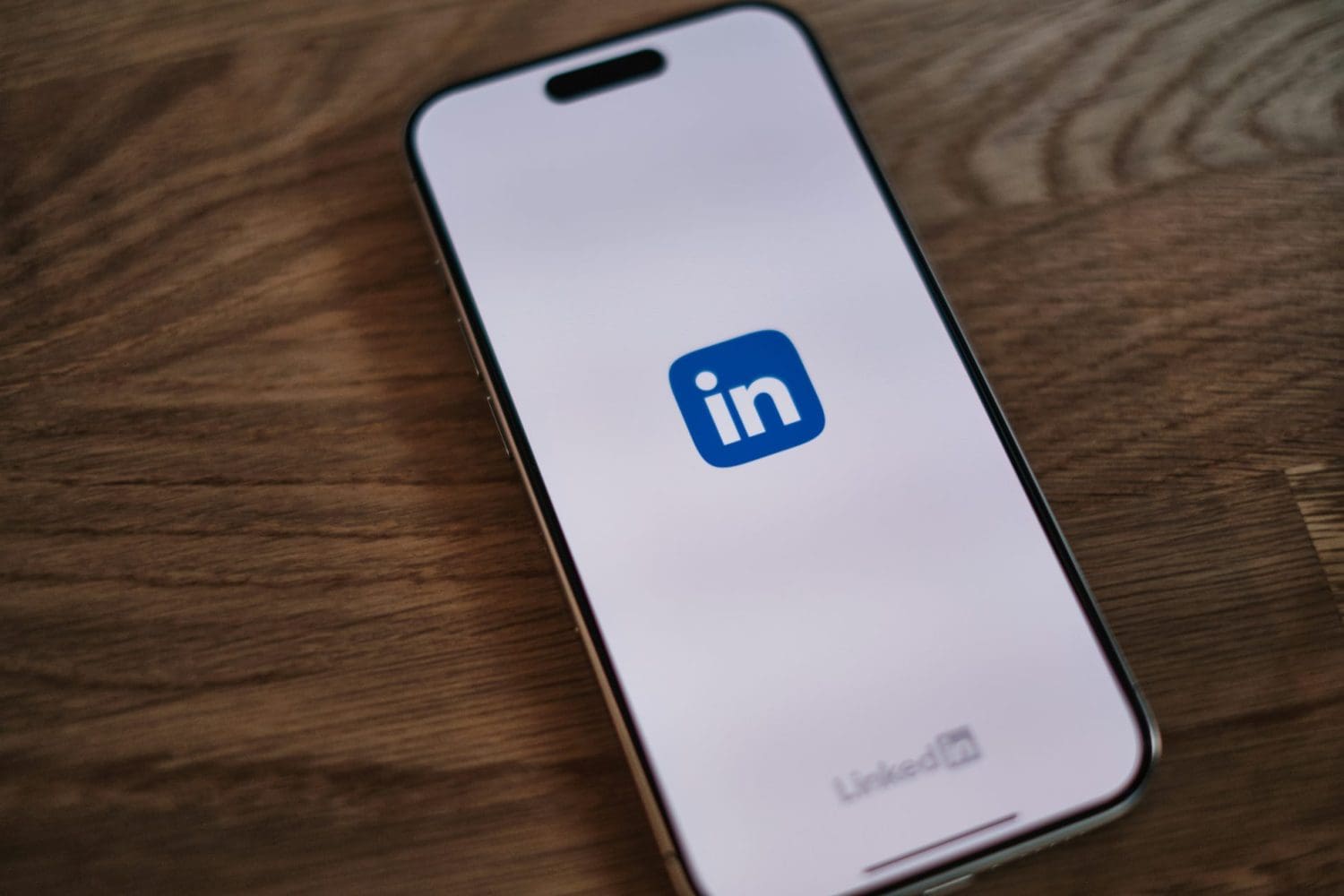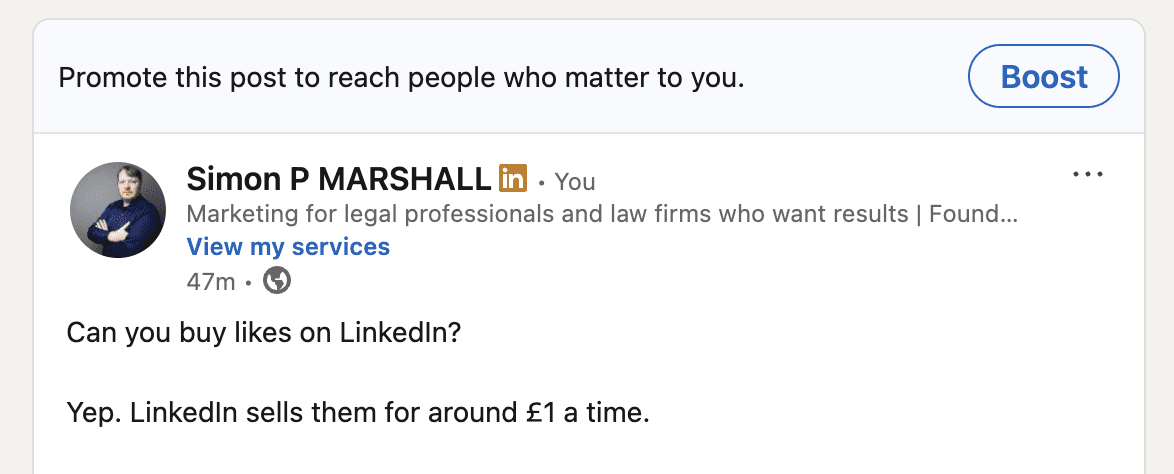I hear you and… I just don’t agree. Here are my thoughts as to why I think that they should. Happy to hear your comments on this, of course.
1. Why should we be giving away our firm’s insights for free?
Because expertise only becomes valuable when people can see it in action. Keeping it locked away doesn’t build trust; it hides you. The clients you want aren’t paying for what you know in theory — they’re paying for how you think. Sharing one small, practical insight doesn’t give away your IP; it proves your judgement.
People want to know you’re expert enough to act on something. Very few want to risk doing it themselves. The more you show what you can do and how you do it, the more you’re left doing the senior work. You also get more accurate instructions because clients already understand your approach.
2. Isn’t LinkedIn just self-promotion dressed up as thought leadership?
It can be, when done badly. But the platform itself isn’t vain — people are. When used properly, LinkedIn is about being useful in public. It’s where professionals make sense of change and help others do the same. You don’t have to talk about yourself to show what you know. The best voices make the reader smarter, not the writer louder.
Under Aristotle’s three pillars of persuasion — credibility, track record and connection — LinkedIn lets you build all three at once. Fail to show technical skill and you won’t be trusted; fail to connect and you won’t be liked. Show your track record, through stories and proof points, and you’ll almost certainly be instructed.
3. Don’t clients think it looks desperate when lawyers post too much?
Only if the content feels needy. Clients don’t count posts; they notice tone. If you sound as though you’re chasing attention, it grates. If you sound as though you’re helping them think, it lands. LinkedIn isn’t about volume, it’s about presence. Regularity signals confidence, not desperation.
If your content adds value, builds connection or reinforces your position, clients won’t be turned off. If they are, they’re probably not the right clients for you. The aim is to attract those who recognise thoughtfulness as a proxy for competence.
4. If our work speaks for itself, why do we need to broadcast it?
Work doesn’t speak. People do. The best matters and deals rarely explain themselves to the market. Visibility isn’t vanity — it’s context. The lawyers who shape how their work is understood are the ones who attract the next opportunity. If you stay silent, someone else will define your story for you.
That’s how the world works in 2025. People research their lawyers before instructing them and before recommending them. Word of mouth now starts online. Most referrals come from people who first looked you up and liked what they found.
5. Isn’t LinkedIn full of recruiters and salespeople — not serious clients?
It used to be. Now it’s where senior clients read, compare and remember. Most in-house lawyers and business leaders spend time there each week to spot credible voices. The noise is real, but so is the reach. You don’t need to dominate the feed; you just need to show up with clarity and substance.
With over a billion users, there’s plenty of both — noise and opportunity. But clients often hang back, quietly observing. Many decide they’ll buy from you long before you meet. I’ve met hundreds of clients first online, then in person. That’s the new order of trust.
6. Why would anyone senior waste billable time writing posts?
Because positioning is billable time at scale. A senior lawyer’s voice online saves dozens of coffee meetings. One well-crafted post can attract the next instruction, hire or panel place. The lawyers who see writing as business development, not blogging, are the ones whose calendars stay full.
It’s the gift that keeps on giving. One post or video might reach two, five or even ten thousand people. There’s no other form of marketing that keeps you front of mind so efficiently or so widely. It’s leverage, not waste.
7. What if someone says something wrong and it reflects badly on the firm?
That risk already exists in every client call, pitch and meeting. LinkedIn just makes the conversation visible. The answer isn’t control; it’s guidance. A firm that teaches people how to write responsibly shows trust and maturity. The occasional misstep hurts less than a culture of silence.
And what if they say nothing and the work goes to a competitor? If you can trust your people to advise clients at hundreds of pounds an hour, you can trust them to post online. One misjudged sentence rarely kills a reputation; invisibility does.
8. Isn’t this marketing’s job, not ours?
Marketing builds reach; lawyers build credibility. One without the other fails. The best posts come from professionals who live the issues, not comms teams polishing them. LinkedIn isn’t advertising — it’s professional proof. Marketing can amplify your message, but only you can author it.
They’re doing their bit. Now they need your people too. Clients buy the lawyer, and want the reassurance of a brand behind them. The two work together — credibility plus amplification — not in sequence.
9. How can we control the message if everyone posts their own thing?
You can’t, and you shouldn’t try. The goal isn’t uniformity, it’s coherence. Give people principles, not scripts. When everyone sounds identical, no one stands out. Trust your lawyers to use their judgement — that’s what you hired them for.
We already train people on positioning and message. Guardrails exist. Freedom within that framework is what builds authenticity. You don’t need one firm voice; you need one firm standard of professionalism.
10. What happens when competitors copy what we put out there?
They already do. Most can copy your words but not your tone or timing. Originality in law isn’t about invention; it’s about interpretation. If others echo your thinking, it proves you set the agenda. Better to be the source that’s quoted than the firm that never speaks.
They might imitate you once or twice, but it takes relentless effort to replicate your thinking every time. Let them try. Being worth copying is the best signal that you’re ahead.
11. But does anyone win any work anyway?
Yes — and not just occasionally. The lawyers who post consistently are remembered when the right brief arises. LinkedIn works like reputation: it compounds. The results rarely come from “I saw your post, please act for us”, but from “you’ve been on my radar for months”. Visibility shortens the time between awareness and instruction.
It does work — otherwise we wouldn’t do it. The question is whether you measure it properly. If you can trace where work originates across marketing and BD, extend that to LinkedIn. The data usually confirms what the anecdotes already suggest.
12. Why would we allow juniors to speak about LinkedIn when they don’t know enough about the law?
Because they know enough about people. Juniors understand the platform better than most partners. Letting them share reflections, learning and gratitude publicly builds confidence and strengthens culture. It also signals a firm comfortable with growth.
Some things juniors can do look awkward if seniors attempt them — being openly curious, thanking mentors, championing future talent. If we focus their energy on that, everyone wins. It’s not a risk; it’s succession planning in plain sight.
13. Won’t it just result in our people getting headhunted?
They already are. LinkedIn visibility doesn’t create that risk; it just exposes it. The stronger a person’s brand becomes, the stronger yours looks for nurturing them. Talent attracts talent. If your retention depends on hiding people, the problem isn’t LinkedIn — it’s culture.
At the moment, you manage all the downside without taking any of the upside. What if they stay because they’re encouraged to find their voice, win work and grow their networks here? Visibility isn’t the enemy of loyalty — suppression is.
Whilst you’re here, you might like to know this…
Cialdini’s principles of influence
Cialdini’s principles of influence are seven psychological shortcuts people use to make decisions: reciprocity, commitment and consistency, social proof, liking, authority, scarcity, and unity. These principles explain why people say “yes” to requests and can be applied ethically in communication and sales to build trust and guide decisions.
The seven principles of influence
- Reciprocity: People feel obligated to give back to others who have given them something first.
- Commitment and consistency: People want to be consistent with their past actions, beliefs, and commitments.
- Social proof (or consensus): People look to the actions and behaviour of others to determine their own, especially when they are unsure.
- Liking: People are more likely to be persuaded by those they know and like.
- Authority: People tend to obey authority figures or experts who have credible knowledge or titles.
- Scarcity: People desire things more when they are perceived as scarce or limited in availability.
- Unity: People are more influenced by those who are part of a shared identity, like family, teammates, or members of a common group.





